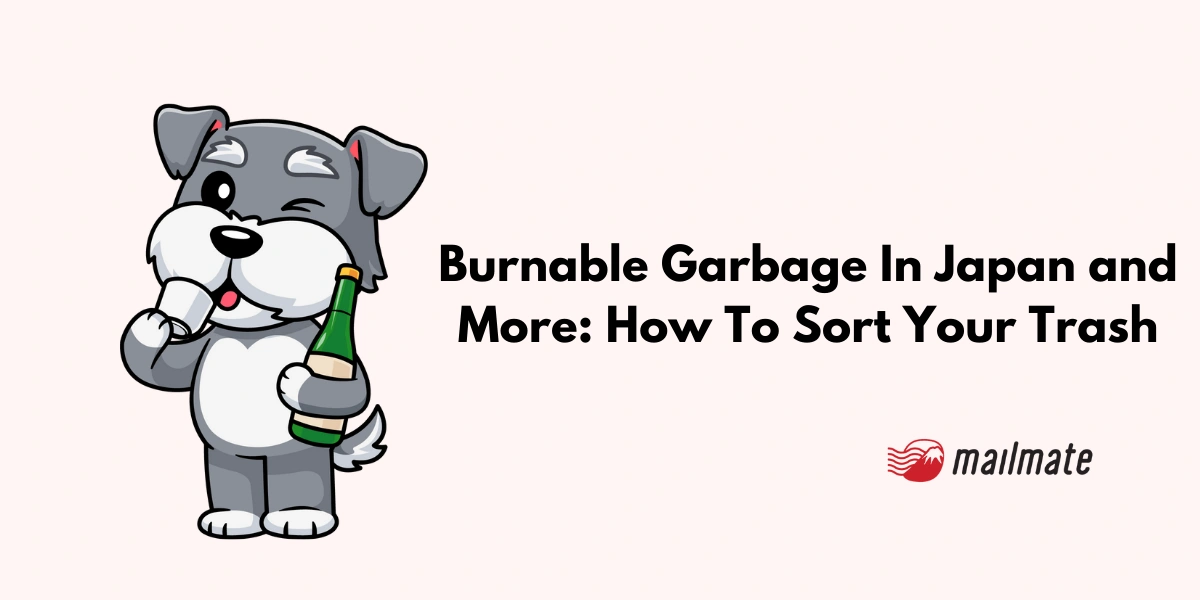Burnable Garbage In Japan and More: How To Sort Your Trash

Japan has a strict waste disposal system that requires residents to follow specific sorting rules to maintain cleanliness and environmental standards.
While every Japanese city and town has specific trash rules, we created this guide to help you understand the general guidelines that most Japanese towns and cities follow.
From burnable garbage in Japan to plastics and more, we have your garbage disposal rules.
What is considered burnable garbage in Japan?
Burnable garbage in Japan (可燃ごみ・燃えるごみ) refers to household waste that can be safely incinerated at municipal facilities. This typically includes food scraps, paper, wood, natural fibers, and some leather items.
In most areas of Japan, burnable garbage is collected one to two times per week using designated municipal trash bags.
Items must be properly sorted, drained of excess liquid, and placed out only on the assigned collection days.
Waste that does not meet local rules may be left uncollected or returned with a warning.
Because trash disposal rules are set by individual municipalities, what counts as burnable garbage can differ depending on where you live. Always follow your local garbage disposal guidelines, even if rules were different in your previous city.
Item |
Burnable? |
Notes |
Food scraps |
✅ |
Drain liquids first |
Greasy paper |
✅ |
If heavily soiled |
PET bottles |
❌ |
Separate recycling |
Plastic wrappers |
⚠️ |
City-dependent |
Small electronics |
❌ |
Non-burnable |
Trash sorting in Japan
When it comes to sorting trash in Japan, you need to know three things:
1. Collection day
Trash in Japan is collected on specific days of the week.
Burnable garbage is generally collected twice a week. In contrast, nonburnable garbage and recyclables are collected less frequently, usually once or twice a month.
The schedule depends on your building, where you live, and the area’s designated collection day.
Check your building’s collection rules for where and when to place your trash.
2. Sorting
Sorting trash in Japan involves separating items into main 3 categories:
Burnable (可燃ごみ, kanengomi)
Non-burnable (不燃ごみ, funengomi)
Recyclables (資源ごみ, shigengomi)
Each type of trash needs to be in a specific color or labeled bag sold at convenience stores or supermarkets. Missorting your trash can result in fines or it not being collected.
Depending on the item, you will need to clean the inside by rinsing it with water and drying it. Mainly to control mold and smells.
Additionally, all your items should fit inside their designated bags. If items are too big, they should be collected as “oversized” garbage.
Ask yourself these questions in order:
Question |
Yes → |
No → |
Is it larger than 30cm in any dimension? |
Sodai Gomi (Schedule pickup) |
Continue to next question |
Does it burn easily? (paper, food, wood, fabric) |
Burnable (可燃ごみ) |
Continue to next question |
Is it metal, glass, or small electronics? |
Non-burnable (不燃ごみ) |
Continue to next question |
Is it a clean plastic bottle or container? |
Recyclables (資源ごみ) |
Check local rules |
3. Regional differences
There are regional trash sorting differences in:
How trash is sorted
How trash is collected
How trash is handled
For example, I lived in Tokyo before and now in Fukuoka. In my Tokyo apartment, my trash needed to be under a specific netting every week. While in Fukuoka, my building has a 24-hour trash area.
Here is a comparison chart showing regional trash sorting differences in Japan's major cities:
City |
Burnable Collection |
Non-burnable Collection |
Plastic Bottles |
Small Plastics |
Special Notes |
Tokyo (Shibuya) |
Mon/Thu |
2nd & 4th Wed |
Every Wed |
Separate bag |
Strict separation required |
Osaka |
Mon/Thu |
2nd Wed |
Tue/Fri |
With recyclables |
More flexible with plastics |
Kyoto |
Tue/Fri |
3rd Thu |
Mon/Wed/Fri |
Burnable trash OK |
Traditional approach |
Fukuoka |
Tue/Fri |
2nd & 4th Mon |
Wed/Sat |
With burnable |
Most relaxed rules |
Yokohama |
Varies by ward |
1st & 3rd Thu |
Tue/Fri |
Separate collection |
Ward-specific schedules |
💡 Pro Tip: Always check with your building manager or local city hall for your specific area's rules, as these can vary even within the same city.
How to separate garbage in Japan
Here is a general guide to sorting your trash in Japan.
Burnable garbage in Japan

Nerima, Tokyo burnable garbage guide
Burnable garbage varies throughout Japan; generally, it includes:
Kitchen waste: leftovers, tea leaves, egg and sea shells
Paper: used paper, cartons, wrapping paper
Leather items: Footwear, bags, belts, etc.
Natural items: flowers, wood scrap, branches
However, burnable garbage can also include small plastics, depending on where you live. For example, my Fukuoka apartment allows plastics in the burnable waste, compared to Tokyo, where it’s much stricter.
You can search for your basic trash guide in Japan by searching:
[Local municipalities] garbage disposal
[City or town in Japanese]ごみ出しルール
Non-burnable garbage in Japan

Nagahama’s City Non-burnable Garbage Guide
Nonburnable garbage in Japan can not be incinerated normally. It includes:
Metals: pots, knives, spoons, umbrellas, and steel cans
Glass and ceramics: cups, ashtrays, cosmetic bottles, broken items, mirrors, bowls, pots,
Small electrical appliances: kettles, toaster, mixer, coffee
For broken items, such as broken bottles or glass, you should wrap them in paper before placing them inside your nonburnable bag. Then label the outside the bad with “Dangerous” or “きけん.”
Additionally, aerosol spray cans and gas cartridges should be placed in a separate transparent bag next to your nonburnable garbage at your garbage collection site.
Plastics in Japan

Mostly, all plastic bottles here are PET bottles and have their own separate sorting bag. These bottles must be rinsed, and the pet bottle caps and labels must be disposed of separately.
Depending on where you live, other recyclable garbage, such as labels, bags, and food containers, can be placed in separate plastic bags or burnable trash bags.
Paper trash in Japan
Paper can be recycled in Japan, and it includes:
packaging and bags
pamphlets
printed paper
envelopes
newspaper and magazine
cardboard
paper cartons
Stack and tie these items and place them in their designated area.
Any paper items that are dirty, have a strong smell, or have silver wrapping should be placed in a burnable container.
Additionally, depending on your building and local garbage disposal rules, these paper items may be placed in burnable trash bags, regardless of how clean they are.
Oversized garage in Japan

Common sodai gomi in Minato, Tokyo , including microwaves, vacuums, and chairs
Oversized garbage is called 粗大ごみ or sodai gomi in Japanese which includes:
Furniture
Appliances
Mattresses
Bicycle
Suitcases
Oversized garbage must be scheduled for a pickup with your local government, or you can take the time to visit a designated disposal center.
There will be a fee for this pickup, though it’s usually less than 500 yen per item. Once you have an item scheduled, you will pay this fee at a convenience store or municipal office, where you will receive the sodai gomi ticket to attach to your item before it is collected.
For more information about scheduling pickups and fees, look up your local sodai gomi by searching: [市, 町, or 区] 粗大ごみ.
Common mistakes when disposing of burnable garbage in Japan
Even residents who understand the basics of trash sorting in Japan often make small mistakes that can lead to uncollected garbage or warnings from their local municipality.
It's important to remember that improperly sorted trash will not be collected and will be marked with a warning sticker, potentially leading to further consequences for repeated offenses.
Below are some of the most common errors to avoid when dealing with burnable garbage (可燃ごみ).
1. Assuming all plastics are burnable
While some cities (such as parts of Fukuoka) allow certain plastics in burnable trash, many municipalities—especially in Tokyo—require plastics to be sorted separately. Always check whether plastic packaging, wrappers, and containers belong in burnable or recyclable waste in your area.
2. Throwing dirty recyclables into burnable trash without checking
Paper or cardboard that is heavily soiled with oil or food residue is usually considered burnable. However, clean paper, cartons, and cardboard should never go into burnable garbage, even if they seem small or insignificant.
3. Forgetting to drain liquids from kitchen waste
Food scraps and leftovers are burnable, but excess liquid can cause odor problems and attract pests. Many cities require residents to drain liquids thoroughly before placing kitchen waste in burnable garbage bags.
4. Putting hazardous items in burnable bags
Items such as batteries, lighters, aerosol cans, and small electronics should never be placed in burnable garbage. These can cause fires or explosions during incineration and are subject to special collection rules.
5. Ignoring bag size and overfilling
Burnable garbage must fit completely inside the designated trash bag. Overfilled or improperly tied bags may not be collected, even if the contents are correctly sorted.
6. Treating “small” items as automatically burnable
Size does not determine category. Small metal objects, glass fragments, and electronic parts are still non-burnable, even if they fit inside a burnable garbage bag.
7. Following rules from a previous city
Trash rules change significantly between municipalities. Moving to a new ward or city without checking local disposal rules is one of the most common causes of sorting errors, even among long-term residents.
💡 Tip: When in doubt, search “[your city name] ごみ出しルール” or consult your building manager or local city hall before disposing of questionable items.
Costs and fees: what you need to budget
Trash bag costs (per 10-bag pack)
Bag Type |
Tokyo |
Osaka |
Kyoto |
Fukuoka |
Burnable (45L) |
¥800 |
¥600 |
¥700 |
¥500 |
Non-burnable (45L) |
¥800 |
¥600 |
¥700 |
¥500 |
Recyclable (45L) |
Free/¥400 |
Free |
¥400 |
Free |
Sodai gomi (oversized trash) fees
Item Type |
Typical Cost |
Notes |
Chair/Small furniture |
¥200-¥400 |
Per item |
Microwave/Small appliance |
¥400-¥800 |
Electronics fee may apply |
Futon/Mattress |
¥500-¥1,200 |
Size dependent |
Bicycle |
¥500-¥800 |
Remove accessories first |
Sofa/Large furniture |
¥1,000-¥2,500 |
May require disassembly |
Advanced trash sorting: tricky items guide
Item |
Correct Category |
Special Instructions |
Pizza box |
Usually burnable |
Remove plastic liner if present |
Aluminum foil |
Non-burnable |
Clean off food residue |
Styrofoam food containers |
Varies by city |
Check local rules - often recyclable if clean |
Clothes hangers |
Metal: non-burnable, Plastic: varies |
Wire hangers always non-burnable |
Makeup containers |
Glass: non-burnable, Plastic: recyclable |
Empty completely first |
Lightbulbs |
LED/fluorescent: special collection, Incandescent: non-burnable |
Never put in regular bags |
Batteries |
Special collection points |
Take to electronics stores or city hall |
Medicine |
Return to pharmacy |
Never put in regular trash |
Essential Japanese vocabulary & phrases
Japanese |
Romaji |
English |
When to Use |
燃えるごみ/可燃ごみ |
moeru gomi/kanen gomi |
Burnable trash |
Most common trash type |
燃えないごみ/不燃ごみ |
moenai gomi/funen gomi |
Non-burnable trash |
Metals, glass, electronics |
資源ごみ |
shigen gomi |
Recyclable trash |
Clean plastics, paper |
粗大ごみ |
sodai gomi |
Oversized trash |
Furniture, large appliances |
ごみ出しルール |
gomi dashi ruuru |
Trash disposal rules |
When asking for information |
分別 |
bunbetsu |
Sorting/Separation |
The act of sorting trash |
きけん |
kiken |
Dangerous |
Label for sharp/broken items |
Frequently asked questions
What is an example of burnable garbage?
Kitchen wastes such as food scraps and leftovers, paper, cartoons, leather items, and wood scraps are examples of burnable garbage in Japan.
What is nonburnable garbage in Japanese?
In Japanese, nonburnable garbage is 不燃ごみ or 燃えないごみ. It includes metal kitchen items, glass and ceramics, and small electrical appliances that fit in nonburnable garbage bags.
What is different about garbage in Japan?
In Japan, household garbage can be separated into 3 categories: burnable, non-burnable, and recyclable.
In closing
Knowing about burnable garbage in Japan and other items to sort out might seem overwhelming at first, but with consistent practice and the guidance in this article, you'll find yourself confidently navigating the rules within just a few weeks.
Spending too long figuring out your Japanese mail?
Virtual mail + translation services start at 3800 per month. 30-day money-back guarantee.

